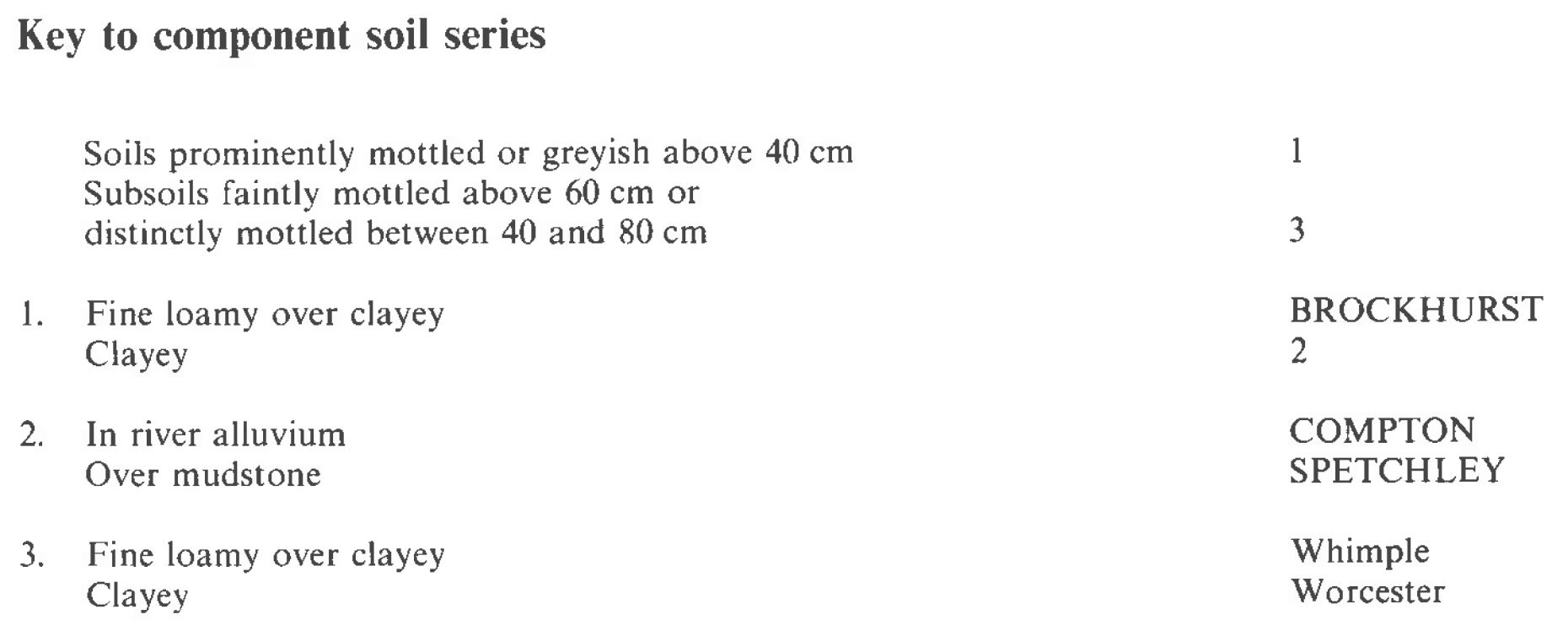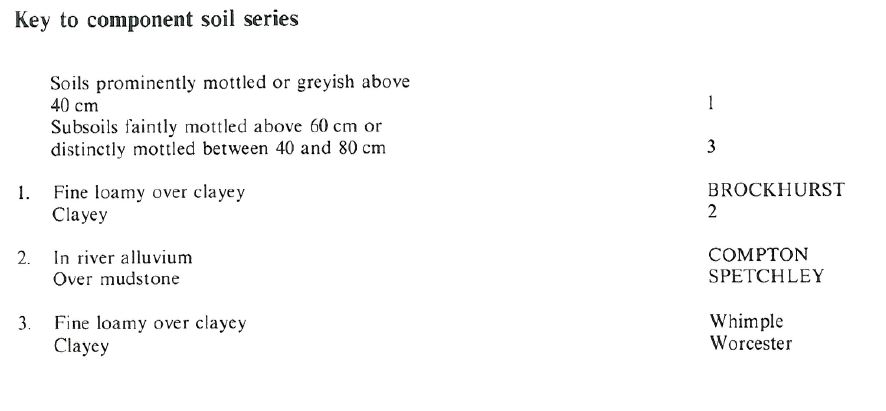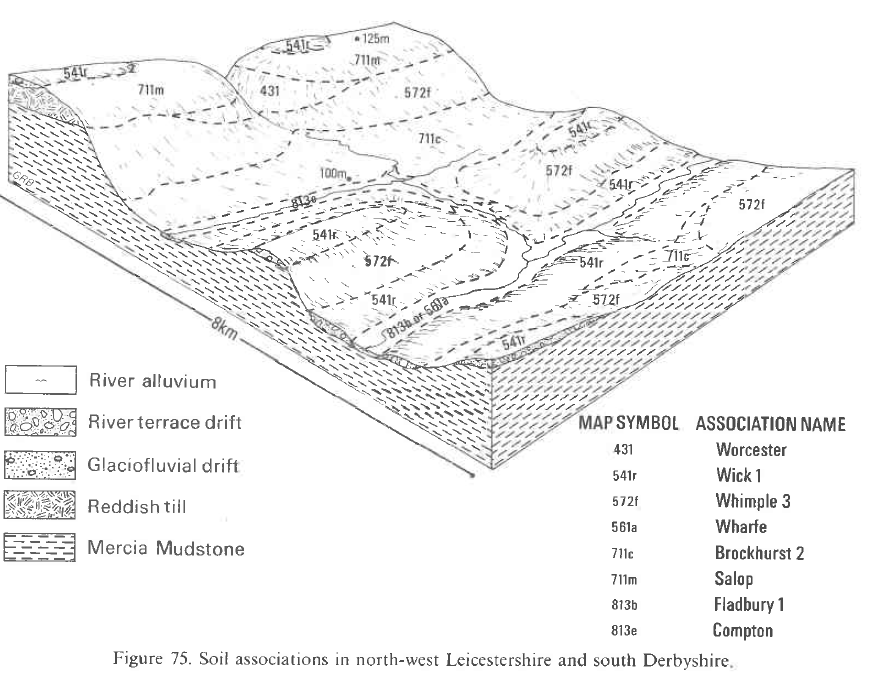
Soil Associations
0711c BROCKHURST 2
Soil and site characteristics
Slowly permeable seasonally waterlogged reddish fine loamy over clayey and clayey soils. Some reddish clayey alluvial soils affected by groundwater.
Geology
Permo-Triassic reddish mudstone and alluvium
Cropping and Land Use
Winter cereals and short term grassland dairying and stock rearing.
Component soil series
| Subgroup | Series name | Percentage | WRB 2006 link |
|---|---|---|---|
| 7.11 | BROCKHURST | 40% | Chromi-Albic Luvic Planosols |
| 7.12 | SPETCHLEY | 25% | Clayic Chromic Eutric Stagnosols |
| 8.13 | COMPTON | 10% | Clayic Fluvic Eutric Gleysols |
Covers 462 km2 in England and Wales
Soilscapes Classification
| 18 |
Slowly permeable seasonally wet slightly acid but base-rich loamy and clayey soils |
0711c BROCKHURST 2
Detailed Description
This association consists of surface-water gley soils and ground-water gley soils on low ground over reddish Permo-Triassic mudstone and clay shale. It occurs mainly in the Midlands but there are small patches in Avon, Gloucestershire, Humberside and South Yorkshire. The association is dominated by soils of the Brockhurst series, typical stagnogley soils, in fine loamy drift over mudstone. Spetchley series, pelo-stagnogley soils, which are found where the mudstone is relatively drift-free and Compton series, pelo-alluvial gley soils, occurs on narrow floodplains. Whimple and Worcester series are on sloping ground that favours run-off and better drainage. Small inclusions of Dale and Wickham soils are found on greenish and greyish mudstones. Hodnet and Greinton soils (Reeve 1976) are locally important where thin sandstone bands are interbeddded with the mudstones.The association covers about 313 km² in the Midlands and is most extensive in Worcestershire and west Warwickshire beyond the main limits of the last glaciation. West of Warwick, it covers about 40 km² on the Arden Sandstone and here includes more Whimple soils than elsewhere but no Compton soils. In south Staffordshire, it includes Salop series and coarse loamy over clayey Hindlip soils (Beard 1984) near the Trent terraces. Greinton, Hodnet and Bromsgrove profiles occur on interbedded fine grained sandstones east of Tamworth and Sutton Coldfield. These soils are also found over similar rocks of Permian age in the Worksop district where Greinton soils cover nearly one-fifth of the land.
The association covers 33 km² in the Chew and Yeo valleys north of the Mendips and only 13 km² in Glocestershire. As elsewhere, Brockhurst series is most common together with Whimple series in gravelly drift swept out of the Mendip combes. Worcester and Spetchley soils occupy small drift-free sites, and Compton soils the wet alluvial bottoms.
This association covers about 50 km², between Worksop and Doncaster on Permian rocks and, on Triassic rocks, surrounding the Isle of Axholme. Whimple soils are locally common but Permian sandstones give Greinton soils which become extensive locally north of Worksop. There are more of the coarse loamy over clayey Hindlip and Dunnington Heath soils than in other regions. Compton soils are inextensive, occurring only on narrow tracts of alluvium.
Soil Water Regime
The clayey subsoil of the Brockhurst series is slowly permeable and water remains in the upper part of the profile for long periods in winter and spring (Wetness Class IV), but a well designed drainage system improves the water regime (Wetness Class III). Clayey Spetchley soils, being slowly permeable throughout, have low hydraulic conductivity making drainage improvement difficult to achieve. Compton soils are affected by groundwater and generally severely waterlogged (Wetness Class V). Because the association occupies level or gently concave land and the soils are slowly permeable, little winter rainfall is absorbed.
Cropping and Land Use
Heavy texture and soil wetness impose considerable limitations upon the use of these soils and cropping is mainly limited to grass and cereal growing, even with adequate underdrainage. Compton soils are almost entirely under permanent grass. The short machinery work period in spring precludes spring-sown crops. Though potential grass yields are large, the risk of poaching restricts grazing to the summer months. The timing of cultivations is critical and autumn ploughing is essential to reduce the risk of compaction and structural damage. Direct drilling is commonly used though yields are similar to those achieved by conventional working. Direct drilling enables large areas of these soils to be sown in the short period when conditions are favourable. In Warwickshire the soils are slightly droughty for cereal crops and moderately droughty for grass. However, in districts with low rainfall, for example near Worcester, grassland suffers from moisture stress in most summers.
In the North autumn sown cereals are the principal crop, though brassicas are grown on a field scale around the Isle of Axholme, and there is some sugar beet. The spring work period is short around Maltby and autumn sown cereals are usual, but in Humberside a longer work period gives greater flexibility. Compton soils, almost without exception, are under permanent pasture. Profile available water of the main soils is moderate and in Humberside they are moderately droughty for cereals, and grass may be severely affected by the lack of soil moisture. In South Yorkshire, where the annual rainfall is 50 mm greater, drought is less significant.
The soils are naturally acid and require regular dressings of lime to maintain neutral status. Cereals and pastures are unlikely to respond to added potassium, but small dressings are necessary for continuous cereals. Phosphorus levels vary, reflecting past management.
0711c BROCKHURST 2
Distribution Map
 |
Note that the yellow shading represents a buffer to highlight the location of very small areas of the association.
Keys to component soil series
Midlands
 |
Northern Region
 |
Typical Landscapes
South Western Region
 |
South Western Region
 |
Midlands
 |
Midlands
 |
Midlands
 |
All information Copyright, Cranfield University © 2025
Citation: To use information from this web resource in your work, please cite this as follows:
Cranfield University 2025. The Soils Guide. Available: www.landis.org.uk. Cranfield University, UK. Last accessed 25/04/2025
